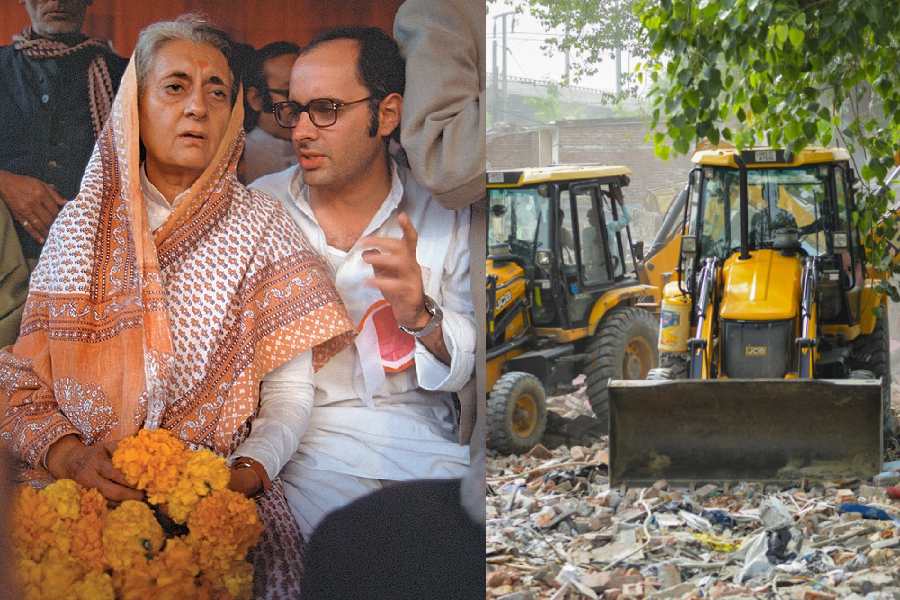 |
As with most artists groomed there, the ashram-like atmosphere of Santiniketan, its idyllic environs (if only they knew what Arcadia was fated to), and its charmingly bucolic people were to Benodebehari Mukherjee (1904-1980) a world in a grain of sand that found eloquent expression in his innumerable drawings and paintings, some the size of postcards, about 70 of which are being exhibited at Akar Prakar in an exhibition titled Works by Benodebehari Mukherjee (until July 14). What set Benodebehari apart from the others is that he lost his vision even before his career peaked, and yet he was not deterred by the pall of darkness and he continued to work.
In one of the most telling exhibits, the entire face of a postcard is coloured black save a tiny dot of red to denote the auspicious occasion on which the card had been posted — Bijoya Dashami. The dark shroud perhaps envisaged the blindness that was to follow.
This collection of mostly pen- and-ink drawings reestablishes Benodebehari’s reputation as a highly sensitive artist. Even in this tiny format, his eye for detail is astonishing. Which is saying a lot for a man who had poor eyesight from childhood. This led to his admission in a Santiniketan school and Kala Bhavan, thereafter. However, his blindness was no handicap, for, as the catalogue — which carries images of all the works on display — explains, “forms, contours and lines gained immense priority in his works” as he lost his sight. The catalogue article is by Debdutta Gupta, who curated the exhibition.
It is said that during Rabindranath’s time, the hills of Bihar were visible from Santiniketan, and it is this land of red soil with its solitary palm trees, scrub, fauna and khoai or ravines formed by the weathering of the red soil close to the river, Kopai, that Benodebehari evokes. Rabindranath’s dream and vision lie fragmented today, abused, warped and distorted beyond recognition, and so Benodebehari’s Santiniketan looks like a thing unreal, something that existed in another plane of reality, perhaps in the poet’s imagination — something that is out of touch with hard, unbearable facts. It is a vulnerable world that shattered into smithereens at the cruel touch of reality.
Think of the wooded hills, the rough-hewn ravines, the snaking rivers, the herds of wild boars and the open skies. This is nature’s domain, and even the picturesque huts, the boats, the dancing Santhals, ashramites making music and meditating under trees are so much a part of this paradise untainted by the human touch. Such a fragile world, which hardly had any grasp of the brutal realities that assailed life, was bound to fall apart.
There is a telling sketch here of a bespectacled man lolling in bed, perhaps daydreaming, with a tea cup by his side and a cigarette in hand. It may be a self-portrait, and even if it is not, it does typify the attitude of artists groomed in Santiniketan. They may have been acutely aware of the tumultuous happenings in the world outside and the upheaval in the universe of art triggered by modernism but that is not reflected in their art. It was as if they were making a conscious effort to insulate themselves to keep their mental peace intact. As ashramites and teachers, they owed that to the sanctity of Santiniketan. Rabindranath, despite Santiniketan being his brainchild, was the only one — later followed by his two famous nephews — to break out of that mould and plumb the dark, unexplored depths of his psyche.
Benodebehari did make a nod to modernism, and this exhibition itself has a paper collage on display. He used newspaper clippings and some paper with floral prints in this non-figurative work. This experiment has little relation with his Bolpur drawings.
However, viewers may find Benodebehari’s robust and bold woodcuts even more appealing than his pen-and-ink drawings. Printmaking was introduced in Santiniketan by several visitors from abroad who sojourned here from time to time and the medium was greatly encouraged by Nandalal Bose, whose linocuts for Sahaj Path look captivating even today. Unlike the composed and pretty drawings, the woodcuts exude a rude energy. The black-and-white areas wrestle with one another to express form — be it the branches of a tree like limbs torn asunder, the pugilist (no shades of Bhupen Khakhar here) being massaged, the man sitting hunched on the ground, or the pesky boar. There is no denying that Benodebehari is solidly grounded here.










